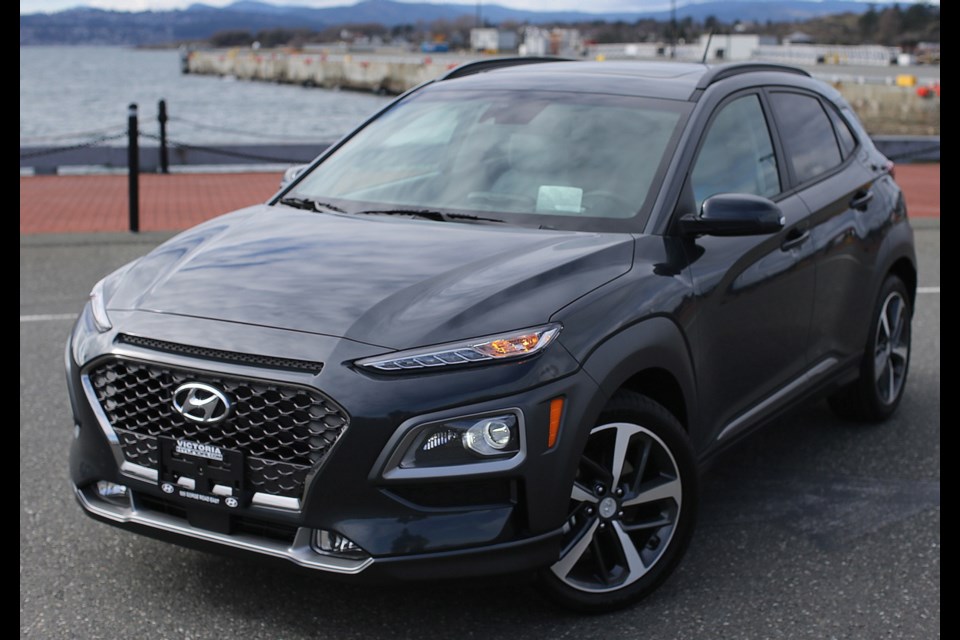I bet there are more than a few anxious manufacturers these days as the 2018 Hyundai Kona hits the streets with funky styling, competitive pricing and a riot of colours.
An all-new model, the Kona takes its place as the smallest and least expensive crossover/SUV in the Hyundai line-up.
It joins competitors such as the Honda HR-V, Jeep Renegade, Nissan Qashqai, Subaru Crosstrek and Mazda CX-3 in the red-hot sub-compact crossover/ SUV segment. You can also include the Toyota C-HR and Kia Soul to the list if front-wheel-drive is all you need.
There is a dizzying number of combinations you can order your Kona, from a base front-wheel drive model that starts from $20,999, to a choice of all-wheel-drive, two engines and five trim options. I drove the top-of-the-line Ultimate trim, with a $31,799 list price.
Hyundai was surprisingly late to the sub-compact segment, a market that has shown sustained, strong growth in the past few years. It follows the market’s embrace of anything that looks like a SUV to the detriment of sedans and hatchbacks.
Hyundai is making up for its tardiness by designing a vehicle that looks like it is ready for anything the urban jungle can throw at it, with chunky body cladding, beefy tires and a look that sets it apart from the competition.
Attention to style is evident, with one model available with a contrasting black roof for a two-tone effect.
Although it shares styling elements with the rest of the Hyundai line, the Kona breaks from the homogeneous look favoured by other manufacturers — this is not a baby Tucson.
The playful exterior isn’t mirrored in the cabin — but that doesn’t mean it is not attractive. The interior of my tester was uplifted by leather upholstery and an eight-inch centre infotainment screen on the top of the centre console stack.
Our tester also came with an integrated wireless phone charger, a nice touch.
The loaded car came with active safety features typically found in near-luxury offerings, such as autonomous emergency braking with pedestrian detection, lane-keep assist, blind-spot detection and rear cross-traffic alert. A heads-up display system is also offered, which gives speed, direction or turn-by-turn instruction for the navigation system.
Two engines are offered, a 2.0-litre four cylinder producing a respectable 147 horsepower and 132 foot-pounds of torque. But the ace up Hyundai’s sleeve is their optional turbocharged 1.6-litre engine that boasts best-in-class 175 hp and 195 lb.-ft. of torque.
And it gets better. While the regular Kona gets a conventional six-speed automatic, the more powerful engine is mated to a seven-speed dual-clutch automatic for snappier changes. This is a combination made in heaven for enthusiasts.
While the 2.0-litre engine can be equipped with either front or all-wheel-drive the 1.6 comes bundled with AWD only.
The driver can select between Eco, Normal and Sport modes, with the car’s computer altering the throttle and transmission programming to suit the driver’s driving style. According to Hyundai, changing the mode also changes the front/rear torque distribution on all-wheel-drive models.
Depending on the model, the Kona can come equipped with 16, 17 or 18-inch rubber.
The rear suspension also changes depending on drive configuration - a simple torsion-beam axle on front-wheel-drive cars and a multi-link suspension for AWD.
When taken together, you soon realize that the Kona exhibits all the attributes that a person looking for a more spirited ride find entertaining.
Cornering is almost flat and the engine pulls eagerly to the redline on Sport mode. The sound of the engine intrudes into the cabin, however.
Up till now the Mazda CX-3 was the go-to vehicle for enthusiasts. With the Kona, that is now a two-way coin toss as to which one is superior.
The Kona is more powerful, but the CX-3 is more than 160 kilograms lighter. Still, the extra power in the turbocharged engine more than carries the Kona on a 0 to 100 km/h dash (Hyundai claims a 7.9-second time).
Despite having a more powerful engine, the turbo 1.6 doesn’t hurt at the gas pump as one would imagine. The engine is actually more fuel-efficient than the naturally-aspirated 2.0 in the city and uses only 0.2 litres per 100 km on the highway (with the combined city/highway rating exactly the same).
The extra power, while frugal, still requires a diet of premium fuel to feed the turbocharged engine.
Hyundai may be late to the party, but that just means more tongues wagging at the sight of the Kona, especially in one of its brighter, eye-popping hues.
THE SPEC SHEET
Type: Subcompact crossover/SUV, front engine, all-wheel-drive
Engine: Turbocharged 1.6-litre four cylinder, 175 hp at 5,500 r.p.m., 195 lb.-ft. of torque at 1,500 to 4,500 r.p.m.
Transmission: Seven-speed dual-clutch automatic
Dimensions (mm): Length, 4,165; width, 1,800; height, 1,565; wheelbase, 2,600
Curb weight (kg): 1,517
Price (base/as tested): $31,799/ $33,704 (includes $1,805 freight and PDI and $100 AC tax)
Options: Nil
Tires: 235/45 R18 on alloy wheels
Fuel type: Premium
Fuel economy (L/100km): 9.0 city/ 8.0 highway
Warranty: Five years/100,000 km new car



